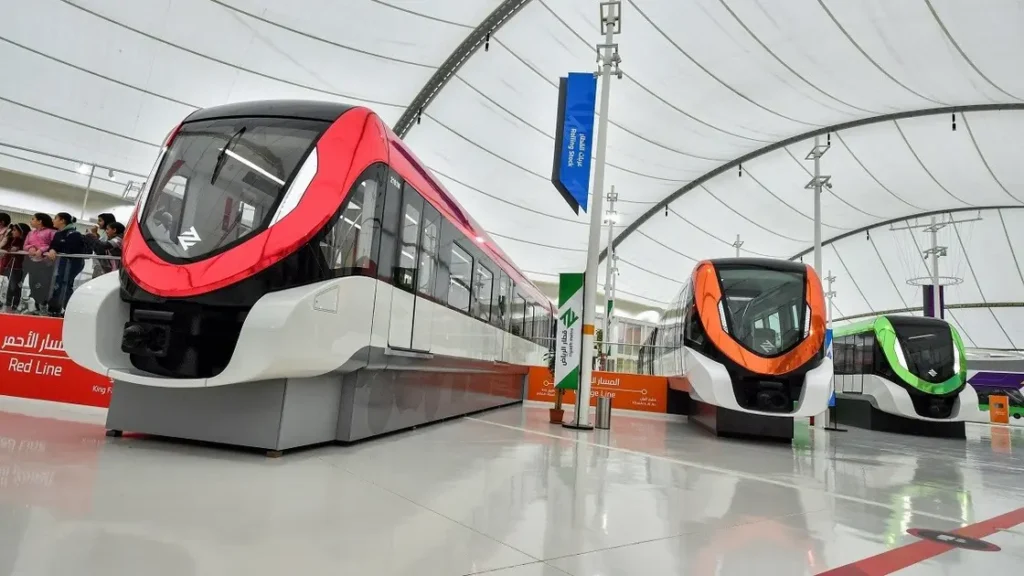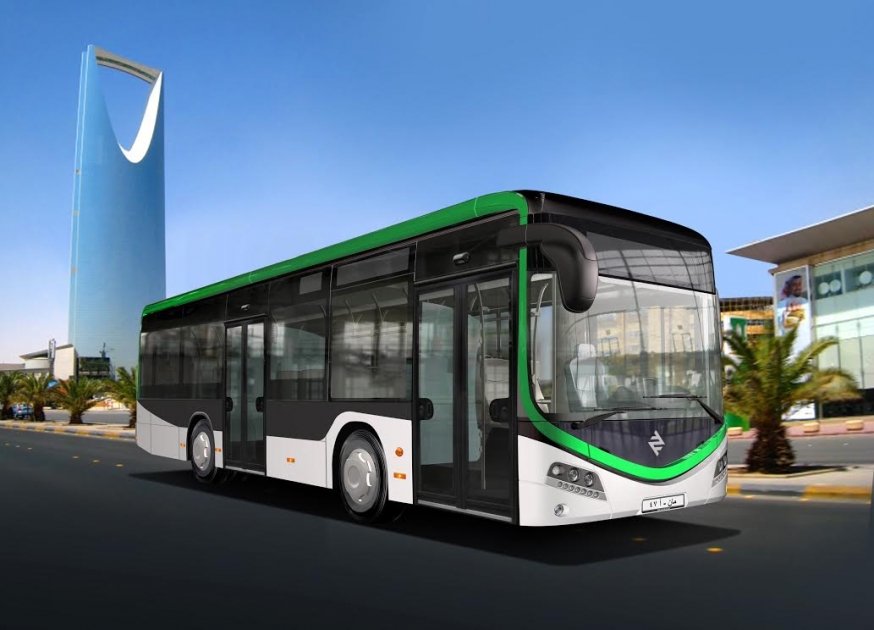Since it started in 2014, the Riyadh Metro has become one of the most eagerly awaited projects in Saudi Arabia.
I’m excited to share that this metro is part of the King Abdulaziz Public Transport Project in Riyadh and is set to start running by the end of 2023 or early 2024.
6 metro lines, 84 metro stations, 80 bus routes, 2,860 bus stops, and 842 buses – that’s the Riyadh Metro for you! It’s the largest single-phase public transport project ever developed in Saudi Arabia – Saudi Gazette.
The Arriyadh Development Authority (ADA) is leading this project, and it’s not just about the metro.
They’re also working on a strong bus system and other transport services all over the city.
Why are they doing all this?
Simple – they want to make Riyadh’s transportation better.
Whether you live here or are just visiting, they’re creating a more efficient and eco-friendly way for everyone to get around.
Riyadh is growing, and by 2030, we’re expecting eight million people.
That’s why the metro is so important.
More people, less traffic, and cleaner air – that’s the goal.
This whole plan got the green light from the Riyadh Council of Ministers in April 2012.
And guess what?
They’re not stopping with just the metro.
They’re also building an 85km three-line Bus Rapid Transport (BRT) network.
This will make it even easier to connect with the metro and get around the city using public transport.
| Project Type | Metro Rail System |
| Location | Riyadh, Saudi Arabia |
| Construction Started | April 2014 |
| Expected Completion | 2024 |
| Estimated Investment | $22.5bn |
Riyadh Metro – Transforming Transportation and Urban Beauty
Let me tell you about the incredible Riyadh Metro project, which is reshaping how we move around the city and changing its look completely.
This project costs a whopping $22.5 billion and brings us stunning stations like Qasr Al-Hukm District, King Abdullah Financial District, Western, and STC.
It’s like a revolution in how we get from one place to another, just like the amazing ‘THE LINE’ project in Saudi Arabia that’s all about smart urban planning and innovation.
One Works, a global design consultancy firm, played a big role in planning the Western Metro Station – Arab News.
What’s really cool is that they took inspiration from our own culture and heritage.
The station is designed to remind us of the Kingdom’s deserts and palm groves.
The structures look like sand dunes, and the colors match the earth.
It’s not just about looks, though.
The design also makes the station welcoming, with lots of light and shaded areas for people to walk around comfortably.
Riyadh Metro Project

The Metro Project is the main support of Riyadh’s public transport, able to carry 1.2 million passengers daily initially and up to 3.6 million when fully realized.
Riyadh, Saudi Arabia, is gearing up for the arrival of 67 cutting-edge, air-conditioned metro trains—comprising both two- and four-car configurations.
They’re so advanced, they can run without a driver!
Perfect for keeping up with the fast-growing population of Riyadh.
It’s like our city is stepping into the future.
Riyadh Metro Lines
1. Blue Line (Line 1)
- Route: Olaya and Batha streets – Dar AlBaida Sports Ground
- Distance: 38 kilometers
- Stations: 22
- Transfer stations: 4
2. Red Line (Line 2)
- Route: King Abdullah Rd. to King Fahd Stadium
- Distance: 25.3 kilometers
- Stations: 13
- Transfer stations: 3
3. Orange Line (Line 3)
- Route: Al Madina Al Monawara Rd. – Prince Saad bin Abdul Rahman Al Awal Rd.
- Distance: 40.7 kilometers
- Stations: 20
- Transfer stations: 2
4. Yellow Line (Line 4)
- Route: King Khaled International Airport Road to the new King Abdullah Financial District (KAFD)
- Distance: 29.6 kilometers
- Stations: 8 (3 common with Line 6)
- Transfer stations: 4
5. Green Line (Line 5)
- Route: start from King Abdul Aziz Road
- Distance: 12.9 kilometers
- Stations: 10
- Transfer stations: 2
6. Purple Line (Line 6)
- Route: KAFD to the Prince Saad Ibn Abdulrahman Al Awal Road
- Distance: 29.9 kilometers
- Stations: 8 (3 common with Line 4)
- Transfer stations: 3
The total route length is 176.4 km.
Riyadh Metro Stations
The Riyadh Metro Project has these four super important stations strategically placed right in the busiest areas where metro lines and the bus network meet.
These stations are like hubs providing all the stuff we need like parking, ticket counters, shops, and customer service offices.
Here are the four main stations:
- Qasr Al-Hukm District Station
- King Abdullah Financial District (KAFD) Metro Station
- Western Metro Station
- STC Station
Features of Riyadh Metro
Let me break down the awesome features of the Riyadh Metro for you:
1. Eco-Friendly Impact
One prominent feature of the project is its commitment to sustainability.
Riyadh Metro incorporates solar cells at stations, contributing to 20 percent of its energy needs.
This initiative is anticipated to cut nearly 250,000 daily car journeys, leading to a substantial reduction in the city’s fuel consumption.
2. Parking Convenience
To make life easier, Riyadh Metro has on-site parking with about 21 lots, each fitting 200-600 cars.
So, when you’re ready to switch from your car to the metro, parking is a breeze.
3. Advanced Security Measures
Safety is a top priority for the metro network.
All metro cars and stations will have advanced security features, including CCTV cameras, early warning systems, firefighting systems, tunnel safety systems, and a communication system for real-time contact with the Control & Operation Center and security personnel.
4. High-Speed Internet Access
Stay productive or entertained during your commute with high-speed internet access across all six main lines.
Riyadh Metro is a connected experience for the modern commuter.
So, whether you want to stay productive or entertained, the Metro has got you covered.
Also read: Must-Visit Tourist Spots in Riyadh of Saudi Arabia
Riyadh Bus Project Overview

Back in April 2012, the Riyadh Council of Ministers gave the green light to this big plan.
They’re not just stopping at buses – they’re creating a three-line Bus Rapid Transport (BRT) network.
These BRT lines are like super highways for buses, linking up the metro stations with the rest of the city’s public transport system.
It’s like creating a seamless web of transportation, making it super easy for everyone to get around Riyadh.
Bus Network and Stations
The fully launched bus network features 2,860 stops and 80 routes, efficiently served by a fleet of 842 buses.
| Bus System Type | Features | No.of Routes | Total Length (km) | |
| Bus Rapid Transit (BRT) | High-capacity corridors ensuring faster, direct, and reliable journeys. | 3 | 160 | |
| Community Lines | Connect key places (hospitals, universities, malls, parks) and connects to BRT and Metro stations. | 19 | 910 | |
| Feeder Lines | Provide seamless connections to the metro and BRT system for efficient and convenient travel. | 58 | 835 |
The Riyadh Bus Project is also introducing a Demand Responsive Transit (DRT) service.
Fancy term, right?
Basically, it means a service that adapts to our needs, especially for the ‘first or last mile’ in residential areas.
So, getting to and from home just got a whole lot easier.
And that’s not all – the bus network comes with different types of stations, a tracking system to keep things on schedule, and a passenger information system for real-time updates.
It’s all about making the system efficient and keeping us in the loop as we travel around Riyadh.
Fleet Details
- Riyadh bus fleet consists of 842 buses and is made up of three bus types 421 Mercedes Citaro G, 179 Mercedes Citaro, and 242 MAN Lion’s City.
- Modern design with on-board Wi-Fi, smart ticketing, and wheelchair accessibility.
- CCTV monitoring for safety standards and a driver performance system.
Environmental Friendly
- They’re all about being green.
- They use ultra-low-sulfur fuel to cut down on CO2 emissions, helping the environment and reducing city traffic.
Supporting Infrastructure
- Four park & ride sites with 200-600 car capacity.
- Two bus depots with maintenance facilities.
- An 80,000 m² Control and Operation Center to manage bus operations, passenger information, tracking, integration with metro networks, ticketing, security, and safety.
Current Status
- Phase 1 launched with over 340 buses, 633 stations, and 15 routes.
- Phase 2 expanded to 223 more buses, 500 stations, and 9 additional routes, covering 1120 km of the total 1900 km service.
Testing and Trial Runs
- Rigorous testing and trial runs ensure service delivery meets operational and safety standards.
- Key performance indicators include service operation, punctuality, trip completion, driver skills, safety adherence, vehicle condition, and cleanliness.
Riyadh Bus Service Expansion
The Royal Commission for Riyadh City just kicked off Stage 4 of the ‘Riyadh Bus’ service, and it’s part of the KAPT network.
What’s that mean?
It’s all about connecting neighborhoods and commercial areas in Riyadh.
Now, they’re adding 7 new routes to make it even better and encourage folks to use buses instead of their own cars.
And the best part?
You can access this service through an online portal and a cool app called ‘Riyadh Bus.’
They’ve got flexible payment options and different types of tickets to choose from, making it super easy and efficient for visitors to get around.
How convenient is that?
Frequently Asked Questions (FAQs)
-
Who is the owner of Riyadh Metro?
Arriyadh Development Authority (ADA) is the owner of Riyadh Metro.
-
Who designed Riyadh Metro?
The late Zaha Hadid and Patrik Schumacher nailed the design competition in 2013 for Riyadh Metro. It’s gonna be huge, connecting three lines and the upcoming King Abdullah Financial District monorail.
-
Is Riyadh Metro driverless?
Absolutely! Siemens Mobility’s futuristic tech fuels the Riyadh Metro. With 41 four-car and 26 two-car driverless vehicles, it’s mobility at its coolest.
-
What is the purpose of Riyadh Metro?
The purpose of Riyadh Metro is to handle the needs of the growing population, making sure we have less traffic and cleaner air.
-
How many kilometers is the Riyadh Metro?
176 km
-
Who is the main contractor of Riyadh Metro project?
The BACS consortium, featuring Bechtel, Almabani General Contractors, Consolidated Contractors Company, Siemens, and AECOM, is tasked with designing and building Lines 1 and 2. These lines are part of the extensive six-line metro system covering 176 kilometers and 85 stations.
Wrap-Up
I’m super excited about the Riyadh Metro transforming how we get around in Riyadh.
Stay tuned for official completion dates and get ready for a journey that’s all about being efficient, sustainable, and super connected.
This metro is a symbol of our country’s dedication to being modern and making progress.
So, buckle up, because we’re all on board for the future of Riyadh’s transport scene!
